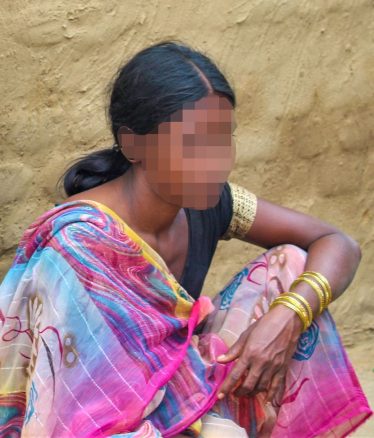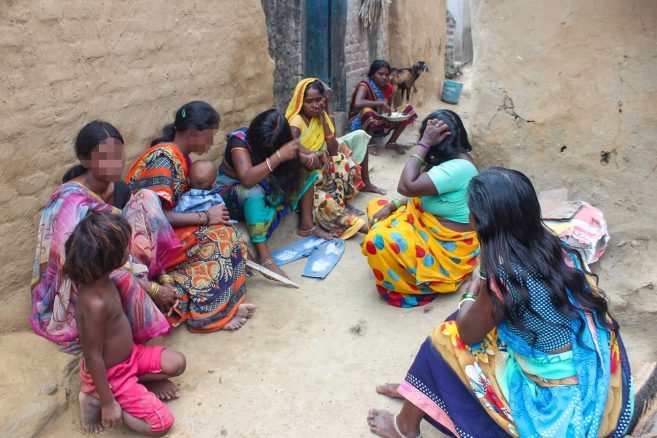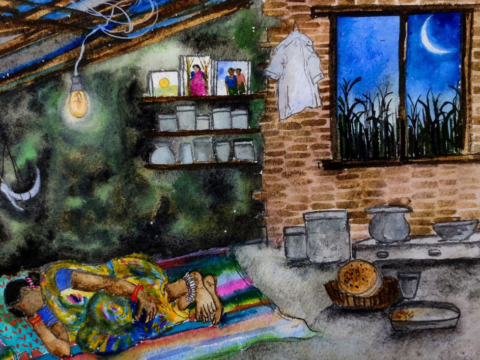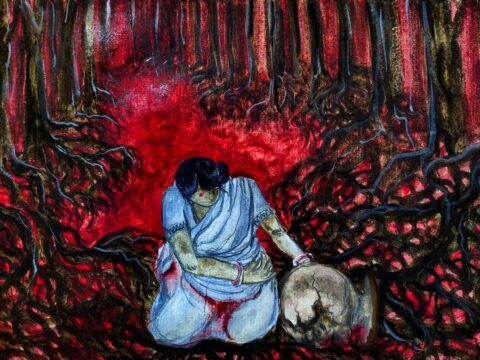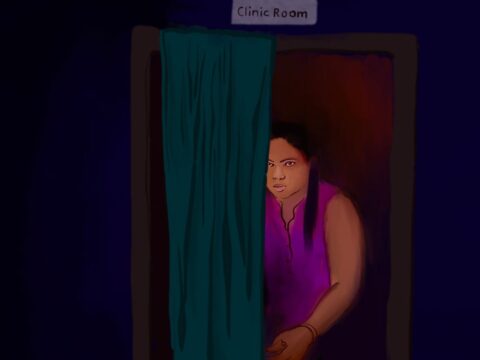
Women from different backgrounds in Bihar’s Gaya district share an existence of penury, poor access to education, and lack of control over their lives, placing their health and well-being at constant risk.
Anjani Yadav came home to her parents after her second delivery in August 2020. She hasn’t returned to her husband and in-laws since. Anjani, 31, and her two children now stay with her parents in Bakraur village of Bodhgaya block in Bihar’s Gaya district. She would rather not name her husband’s village though it is less than half an hour away.
“Two days after I had my delivery at the government hospital, my bhabhi [husband’s sister-in-law] asked me to cook and to clean the house. She said that she had done the same for the household when she had arrived there after giving birth to a child. She is 10 years older than me. I had an excessive loss of blood during my delivery. Even before childbirth, the nurse had said that I had a bad khoon ki kami [severe anaemia] and need to eat fruits and vegetables. If I had remained in my in-laws’ home, my situation would have deteriorated.”
Anaemia in children and women has worsened in the past half a decade across most states and union territories, according to the latest National Family Health Survey (NFHS-5).
Anjani adds that her husband Sukhiram, 32, works in Surat, Gujarat, in a fabric company. He has not been to his home for a year and a half. “He was supposed to come for my delivery, but his company warned that if he took leave for more than two days, they would fire him. Things have worsened for us poor after this Corona bimari, financially, emotionally and health-wise. So, I was all alone, dealing with everything myself.
“That’s why I had to escape the deadly situation it was becoming for me in his absence. Forget about post-natal care, nobody would help me do the chores or even help look after the baby,” she told PARI. Anjani Yadav is still highly anaemic. Just like millions of other women in this state.
NFHS-5 reports that nearly 64 percent of women in Bihar suffer from anaemia.
India has made “no progress…towards achieving the target of reducing anaemia among women of reproductive age, with 51.4 percent of women aged 15 to 49 years now affected,” says the 2020 Global Nutrition Report in the context of Covid-19.

Anjani Yadav has been staying in her parents’ home after her second child was born last year. She had no help or care at her in-laws’ house, and her husband lives far away
After her wedding six years ago, Anjani, like most married Indian women, went on to live with her in-laws, in a nearby village. Her husband’s family included his parents, two elder brothers, their wives and their children. Anjani had dropped out of school after Class 8, and her husband after Class 12.
The adolescent fertility rate for women in the 15-19 age group in Bihar is 77 percent, says NFHS-5. Over 25 percent of all women in the state have a below-normal Body Mass Index (BMI). And over 63 percent of pregnant women between 15 and 49 years of age are anaemic, says the survey.
At her parent’s home in Bakraur, Anjani lives with her mother, brother, his wife and their two children. While her brother, 28-year-old Abhishek, works as a delivery man in Gaya town, Anjani’s mother also works there as a domestic worker. “Overall, our family’s combined earnings come to around Rs. 15,000 a month. Though nobody has got a problem with me staying here, I feel like an added burden on them,” she says.
“My husband lives in a shared room in Surat with three other co-workers. I am waiting for him to save enough and rent a separate house so that we all can live together there [in Surat],” says Anjani.
*****
“Come – I will take you to my friend, whose mother-in-law has made her life also hell, equally,” Anjani says, and I follow her to Gudiya’s house. Her husband’s, actually. Gudiya, 29, is a mother of four. Her youngest child is a boy, and her mother-in-law has not allowed her to undergo sterilisation because she wants her to produce at least one more male child. Gudiya, who prefers to go with only her first name, is from a Dalit community.
Anaemia in children and women has worsened in the last half a decade across most states and union territories, according to NFHS-5.
“My mother-in-law wanted a son after I had three daughters. Then I had a son and thought my life would be easier after that. But now she says that if you have three daughters, there must be at least two sons. She is not letting me get operated,” Gudiya told PARI.
According to Census 2011, Gaya ranks third in Bihar in terms of child sex ratio. The district’s ratio is 960 in the 0-6 age group against the state average of 935.
Gudiya lives in a tin and asbestos-covered two-room house that is made of mud and has no toilet. Her husband, Shivsagar, 34, his mother, and their children are the others living in this tiny home. Shivsagar is a helper in a local dhaba.
Married at the age of 17, Gudiya has never been to school. “I was the first of five daughters in our family and my parents could not afford to send me to school,” she told us. “But two of my sisters and our only brother, the youngest of us all, have been to school.”
The main room in Gudiya’s house opens out onto a narrow street, barely four feet in width, almost into a neighbour’s home on the opposite side. Two school bags are hanging on a wall in the room, still stuffed with books. “These belong to my older daughters. They have not touched them for over a year now,” says Gudiya. Those daughters, 10-year-old Khushboo and 8-year-old Varsha continue to lose out on learning. Schools here are yet to reopen after being shut down at the time of the first national lockdown resulting from the Covid-19 pandemic.
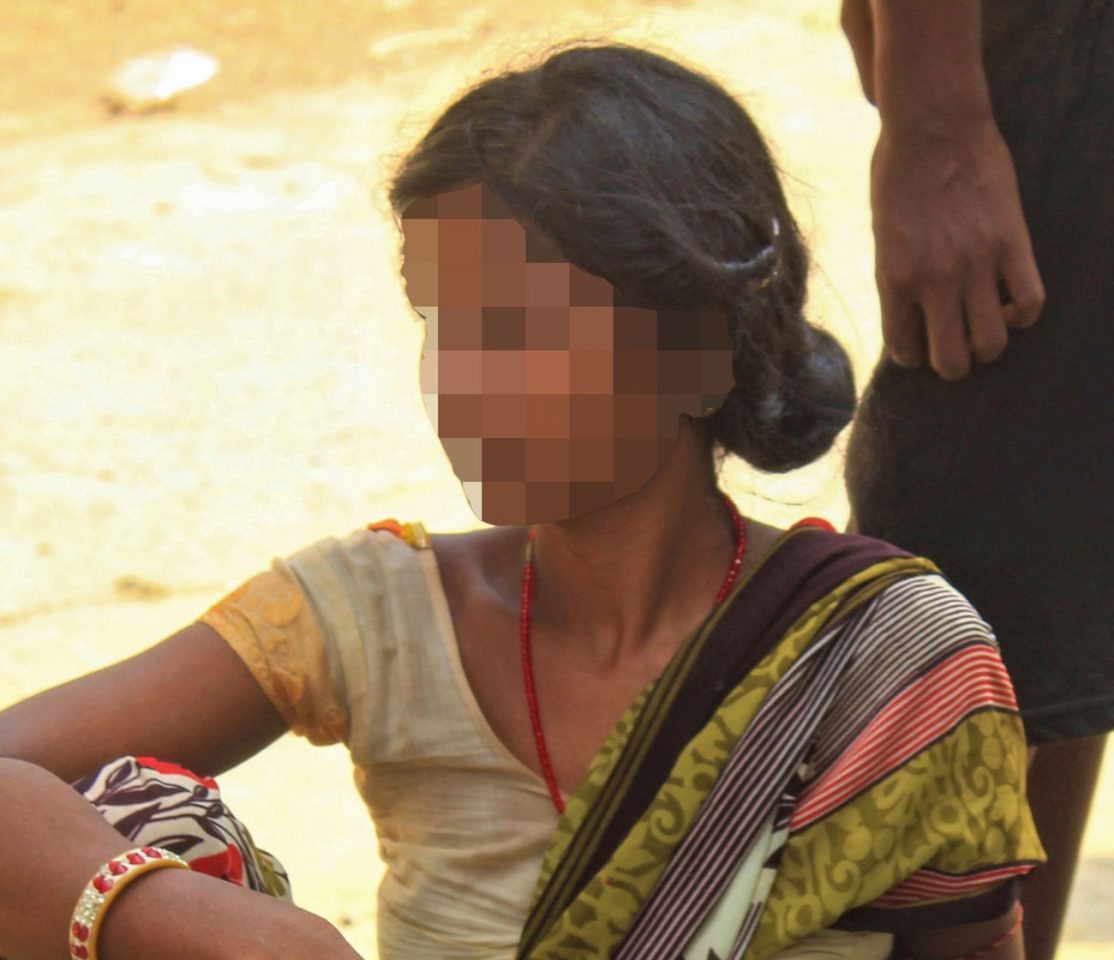
Gudiya’s mother-in-law has not allowed her to undergo sterilisation because she wants her to produce another boy
“At least two of my children used to get proper food once a day as their mid-day meal. But now we are all surviving on whatever we can afford,” says Gudiya.
The school closures have sharpened their hunger. With the two older girls now having no access to mid-day meals, there is less to go around at home. Like Anjani’s family, Gudiya’s too has neither steady employment nor food security. This seven-member household is entirely dependent on the Rs. 9,000 a month her husband earns from an unstable job.
According to the 2020 Global Nutrition Report, “informal economy workers are particularly vulnerable because the majority lack social protection and access to quality health care and have lost access to productive assets. Without the means to earn an income during lockdowns, many are unable to feed themselves and their families. For most, no income means no food, or, at best, less food and less nutritious food.”
Gudiya’s family seems to fit the picture the report paints perfectly. They battle hunger and, being Dalit, prejudice as well. Her husband’s job is far from secure. And the household has no access to healthcare at all.
*****
As the sun sets, it’s life as usual in the Musahar tola (basti or colony) of Bodhgaya block. After finishing their chores for the day, women of this community – which languishes at the bottom of Scheduled Caste groups in the state – have gathered to spend their evenings together, chatting, picking lice from the hair of their children and each other as well.
All of them sit at the doorstep or entrance of their tiny homes, which line a very narrow street bordered by overflowing drains on both sides. “Oh, isn’t this how they describe Musahar tolas ? We are used to living amidst dogs and pigs,” says Maala Devi, 32, who has lived in this colony since right after her marriage when she was barely 15.
Her husband, 40-year-old Lallan Adibasi, is a cleaner at a private clinic in Gaya district headquarters. Maala says she never had the option of tubal ligation and now wishes she had just one child instead of four.
Their eldest son, 16-year-old Shambhu, is the only one enrolled in a school – in Class 9. “I could not afford to keep my daughters studying after Class 3. Lallan gets just 5,500 rupees per month and we are six. You think it would meet our needs?” she asks. Maala’s eldest and youngest kids are boys. The other two are girls.
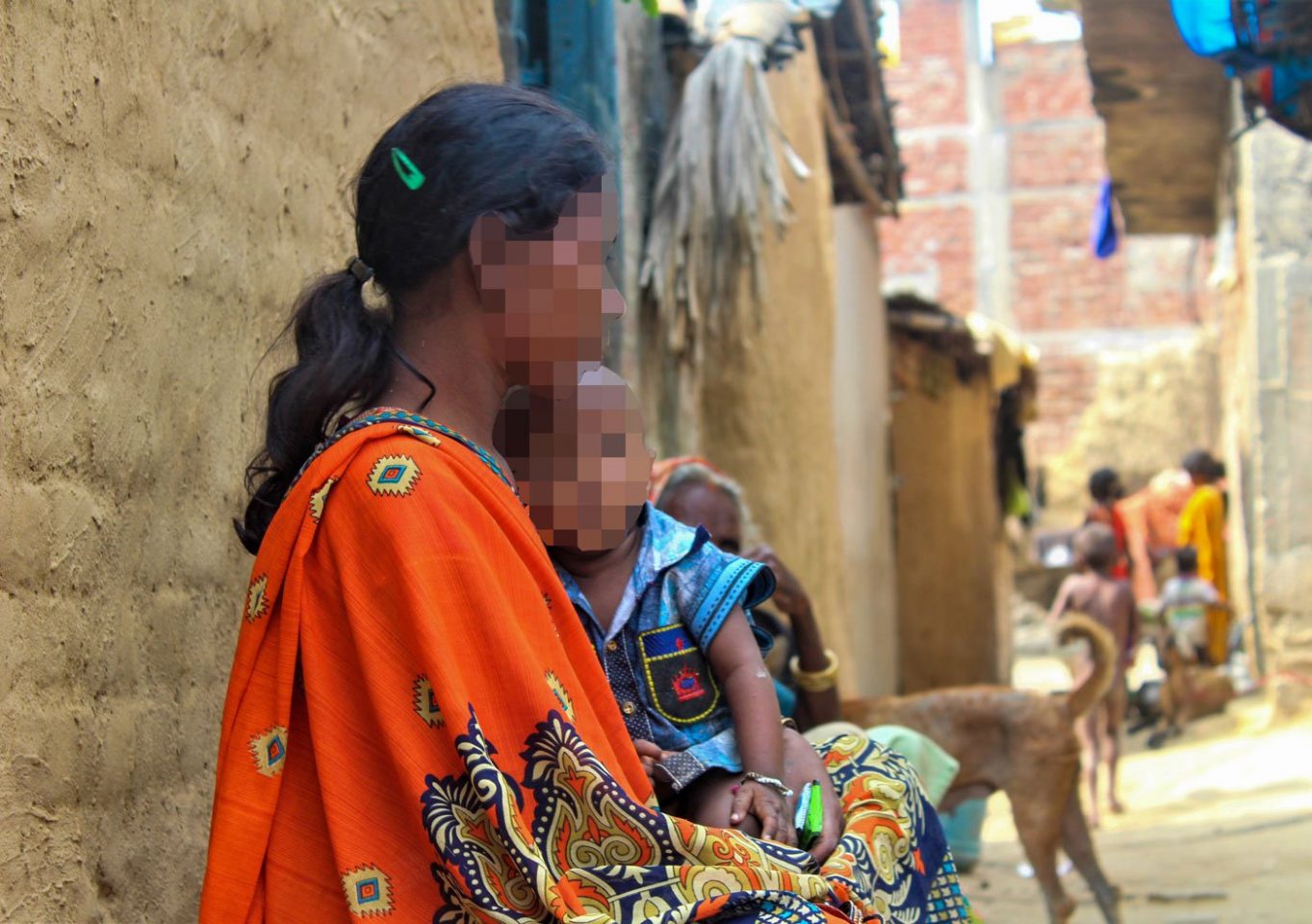
Maala Devi says she never had an option of tubal ligation and now she wishes she had just one child instead of four
Here too, with educational institutions shut, the few children in this tola who were going to school are now unable to do so. Which means a loss of the mid-day meal and sharpening of hunger. Even at the best of times, fewer children from this community go to school. Social prejudice, discrimination, and economic pressures mean that Musahar children, particularly girls, tend to drop out of school earlier and at a faster rate than those of most other communities.
Census 2011 counted nearly 2.72 million Musahars in Bihar. They are the third-largest Scheduled Caste group, after Dusadhs and Chamars. They account for around one-sixth of the 16.57 million Dalits in the state – but make up just about 2.6 percent of Bihar’s total population of 104 million (2011).
An OXFAM report of 2018 says, “About 96.3 percent of Musahars are landless and 92.5 percent work as farm labourers. Literacy rates among this community, which upper-caste Hindus still consider untouchable, is only 9.8 percent, the lowest among Dalits in the country. Literacy among women of the community is around 1-2 percent.”
The tragedy of that literacy rate hits you here in Bodhgaya – once the site of Gautama’s enlightenment.
“We are just made to produce children and feed them, but how do I do that without any money?” Maala asks as she hands over a bowl of leftover rice from the previous night to her youngest son. “This is what I have for you now. Eat or starve,” she tells him, her helplessness bursting out in anger.
Left: After her husband’s death, Shibani depends on his brother to make ends meet. Right: Women in Bodhgaya’s Musahar colony spend their evenings together in the narrow street outside their homes
Another woman in the group is Shibani Adibasi, 29. After her husband’s death from lung cancer, Shibani lives with her two children and her husband’s family in an eight-member household. She has no direct source of income and hence depends on her husband’s brother to make ends meet. “I cannot ask him to get vegetables, milk and fruits for my children and me, exclusively. Whatever he feeds us, we are grateful for it. Most days we survive on maar-bhaat (watery rice cooked with salt),” Shibani tells PARI.
“Almost 85 percent of Bihar’s Musahar population,” says the OXFAM report, “suffers from malnutrition…”
The stories of Maala and Shibani are different only in degree from those of countless other Dalit women living in the Bihar countryside.
Nearly 93 percent of Bihar’s Scheduled Caste population resides in rural areas. Among the state’s districts, Gaya has the highest proportion of Dalits at 30.39 percent. The Musahars fall within the state category of ‘Mahadalit’ – or the poorest social groups within the Scheduled Castes.
Anjani, Gudiya, Maala and Shibani are from somewhat different social and economic backgrounds. But all of them have this in common – a complete lack of control over their own bodies, their health, indeed their lives. They also, perhaps to different degrees, confront hunger. Anjani still fights anaemia many months after her last delivery. Gudiya has given up on the idea of getting herself sterilised. Maala and Shibani have long ago stopped aiming for any kind of a better future – survival is hard enough.
The names of people have been changed in this story to protect their identities.
PARI and CounterMedia Trust’s nationwide reporting project on adolescent girls and young women in rural India is part of a Population Foundation of India-supported initiative to explore the situation of these vital yet marginalised groups, through the voices and lived experience of ordinary people.
Want to republish this article? Please write to zahra@ruralindiaonline.org with a cc to namita@ruralindiaonline.org .
Jigyasa Mishra reports on public health and civil liberties through an independent journalism grant from the Thakur Family Foundation. The Thakur Family Foundation has not exercised any editorial control over the contents of this reportage.

